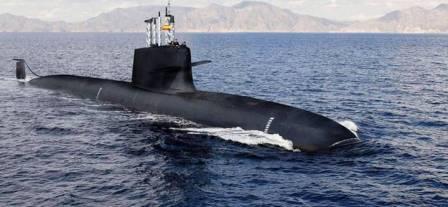
A representational photo.
NEW DELHI (PTI): The Indian Navy is understood to have quietly commissioned into service the country's first indigenous nuclear powered submarine INS Arihant which is capable of firing nuclear weapons, completing India's nuclear triad.
The Defence Ministry and the Navy did not confirm or deny reports that the submarine was inducted in August this year to complete the nuclear weapons triad that gives the country capability to launch nukes from land, air and sea.
Navy and defence officials maintained on Tuesday that the matter does not come under their purview.
At a press conference on Tuesday, Vice Admiral G S Pabby ducked six questions on Arihant but indicated that a formal announcement might be made in the coming days.
"There will soon be an opportunity to talk about it," Pabby said when faced with persistant questions.
Dr G Satheesh Reddy, Scientific Advisor to Defence Minister, also refused to talk about the subject, saying it did not come under his purview.
INS Arihant is a 6,000-tonne SSBN (ship submersible ballistic, nuclear (SSBN) submarine), that can carry ballistic missiles with nuclear warheads.
SSBNs are equipped with better stealth features and are larger compared to SSNs, which are nuclear-powered attack submarines.
The SSBNs are the best bet when it comes to a retaliatory strike to a nuclear attack.
INS Arihant is propelled by an 83 MW pressurised light-water reactor at its core which was developed following extensive help by the Russians.
India's quest for its indigenous nuclear submarine began in late 1990s under top secret project called Advanced Technology Vessel (ATV). The plan was to build three such submarines.
In 2009, Arihant was launched into the water at the ship-building centre in Visakhapatnam. In 2013, the nuclear reactor of the submarine went 'critical'. Since then, the submarine has gone numerous trials including missile firing trials as early as March this year.
The second nuclear submarine, INS Aridhaman is already under construction.
Arihant is integrated with "K" (named after former president APJ Abdul Kalam) series of missiles.
While the K-15 has a 750-km range, the K-4 can go up to 3,500-km. The K-5 has a much higher range. However, it is not confirmed whether the full integration of missiles have taken place or not.
 Previous Article
Previous Article Next Article
Next Article













The Indian Air Force, in its flight trials evaluation report submitted before the Defence Ministry l..
view articleAn insight into the Medium Multi-Role Combat Aircraft competition...
view articleSky enthusiasts can now spot the International Space Station (ISS) commanded by Indian-American astr..
view article